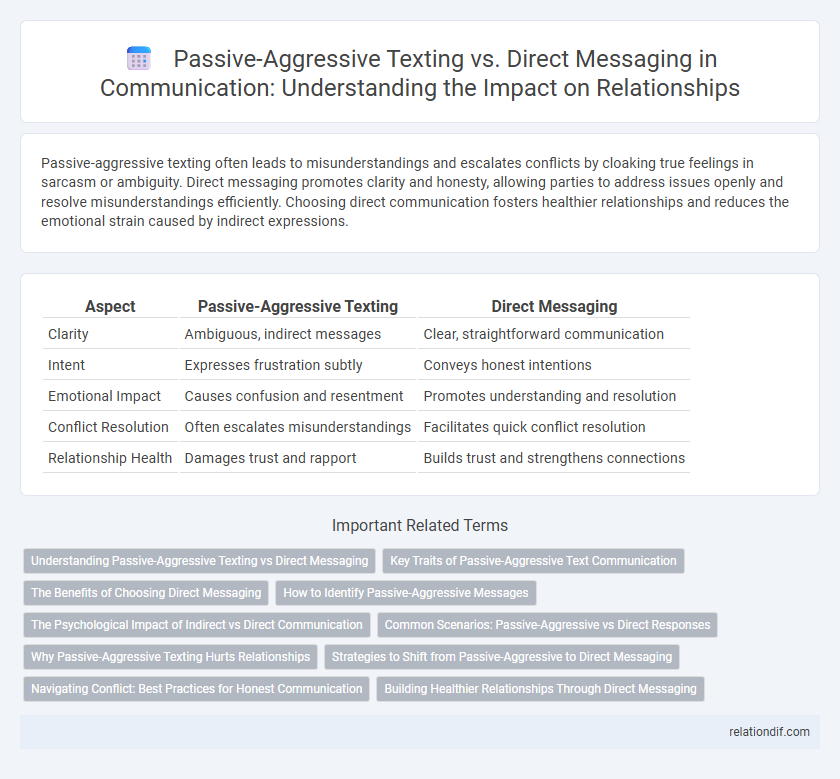Passive-aggressive texting often leads to misunderstandings and escalates conflicts by cloaking true feelings in sarcasm or ambiguity. Direct messaging promotes clarity and honesty, allowing parties to address issues openly and resolve misunderstandings efficiently. Choosing direct communication fosters healthier relationships and reduces the emotional strain caused by indirect expressions.
Table of Comparison
| Aspect | Passive-Aggressive Texting | Direct Messaging |
|---|---|---|
| Clarity | Ambiguous, indirect messages | Clear, straightforward communication |
| Intent | Expresses frustration subtly | Conveys honest intentions |
| Emotional Impact | Causes confusion and resentment | Promotes understanding and resolution |
| Conflict Resolution | Often escalates misunderstandings | Facilitates quick conflict resolution |
| Relationship Health | Damages trust and rapport | Builds trust and strengthens connections |
Understanding Passive-Aggressive Texting vs Direct Messaging
Passive-aggressive texting often involves ambiguous or sarcastic remarks that mask true feelings, leading to misunderstandings and increased tension in communication. Direct messaging prioritizes clarity and honesty, allowing the sender to express thoughts and emotions straightforwardly, which promotes effective problem-solving and trust. Recognizing these differences helps individuals choose healthier communication strategies to resolve conflicts and improve relationships.
Key Traits of Passive-Aggressive Text Communication
Passive-aggressive text communication often features ambiguous language, vague statements, and indirect expressions of frustration or anger. Messages may include sarcasm, subtle insults, or backhanded compliments, making the true intention difficult to decipher. This communication style avoids open confrontation, leading to misunderstandings and prolonged conflict.
The Benefits of Choosing Direct Messaging
Direct messaging fosters clearer and more effective communication by promoting transparency and reducing misunderstandings. It encourages openness and immediate feedback, which helps resolve conflicts faster and builds trust in personal and professional relationships. This approach minimizes emotional misinterpretations often caused by passive-aggressive texting, leading to healthier and more constructive interactions.
How to Identify Passive-Aggressive Messages
Passive-aggressive messages often contain subtle sarcasm, ambiguous compliments, or indirect complaints that mask true feelings, making them harder to interpret. Key indicators include vague language, backhanded remarks, delayed responses, and excessive use of ellipses or emojis intended to soften criticism. Recognizing these patterns helps differentiate passive-aggressive texting from direct messaging, which prioritizes clarity, honesty, and straightforward expression of thoughts.
The Psychological Impact of Indirect vs Direct Communication
Passive-aggressive texting often leads to misunderstandings, increased anxiety, and emotional distress due to its ambiguous and indirect nature. Direct messaging promotes clarity, fosters trust, and reduces emotional uncertainty by enabling honest expression of thoughts and feelings. Research in communication psychology highlights that clear, explicit communication minimizes conflict and enhances relationship satisfaction compared to indirect, passive-aggressive exchanges.
Common Scenarios: Passive-Aggressive vs Direct Responses
Passive-aggressive texting often appears in scenarios where individuals avoid confrontation by sending vague or sarcastic messages, such as ignoring questions or replying with delayed, curt responses. In contrast, direct messaging features clear, concise communication that addresses issues head-on, like providing straightforward answers or expressing feelings openly. Common examples include workplace misunderstandings, relationship disputes, and social group conflicts where clarity versus ambiguity significantly impacts outcomes.
Why Passive-Aggressive Texting Hurts Relationships
Passive-aggressive texting undermines trust by conveying hidden anger or resentment, leading to misunderstandings and emotional distance. Unlike direct messaging, which fosters clarity and openness, passive-aggressive communication causes confusion and escalates conflicts. Persistent passive-aggressive texting erodes relationship quality, increasing frustration and reducing healthy dialogue over time.
Strategies to Shift from Passive-Aggressive to Direct Messaging
Shifting from passive-aggressive texting to direct messaging requires adopting clear and assertive language, focusing on expressing feelings and needs without blame. Practicing active listening helps in understanding the recipient's perspective, promoting empathy and reducing misunderstandings. Establishing boundaries and encouraging open dialogue fosters trust and strengthens communication effectiveness in both personal and professional relationships.
Navigating Conflict: Best Practices for Honest Communication
Passive-aggressive texting often obscures true feelings, leading to misunderstandings and escalating conflicts, whereas direct messaging fosters clarity and accountability by expressing issues honestly and respectfully. Effective conflict navigation includes stating concerns explicitly, using "I" statements to own emotions, and actively seeking mutual understanding. Prioritizing transparent communication reduces ambiguity, promotes resolution, and strengthens relationships through trust and openness.
Building Healthier Relationships Through Direct Messaging
Direct messaging fosters healthier relationships by promoting clarity and reducing misunderstandings often caused by passive-aggressive texting. Clear and honest communication builds trust, encourages openness, and resolves conflicts efficiently. Consistent use of direct messaging strengthens emotional connections and supports mutual respect.
passive-aggressive texting vs direct messaging Infographic

 relationdif.com
relationdif.com